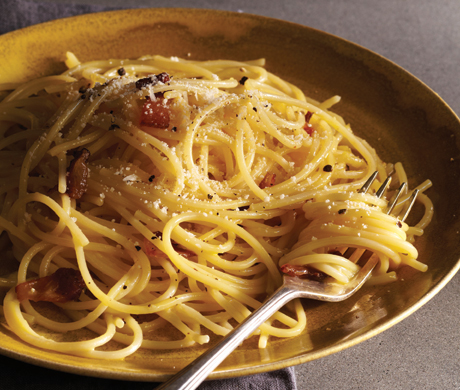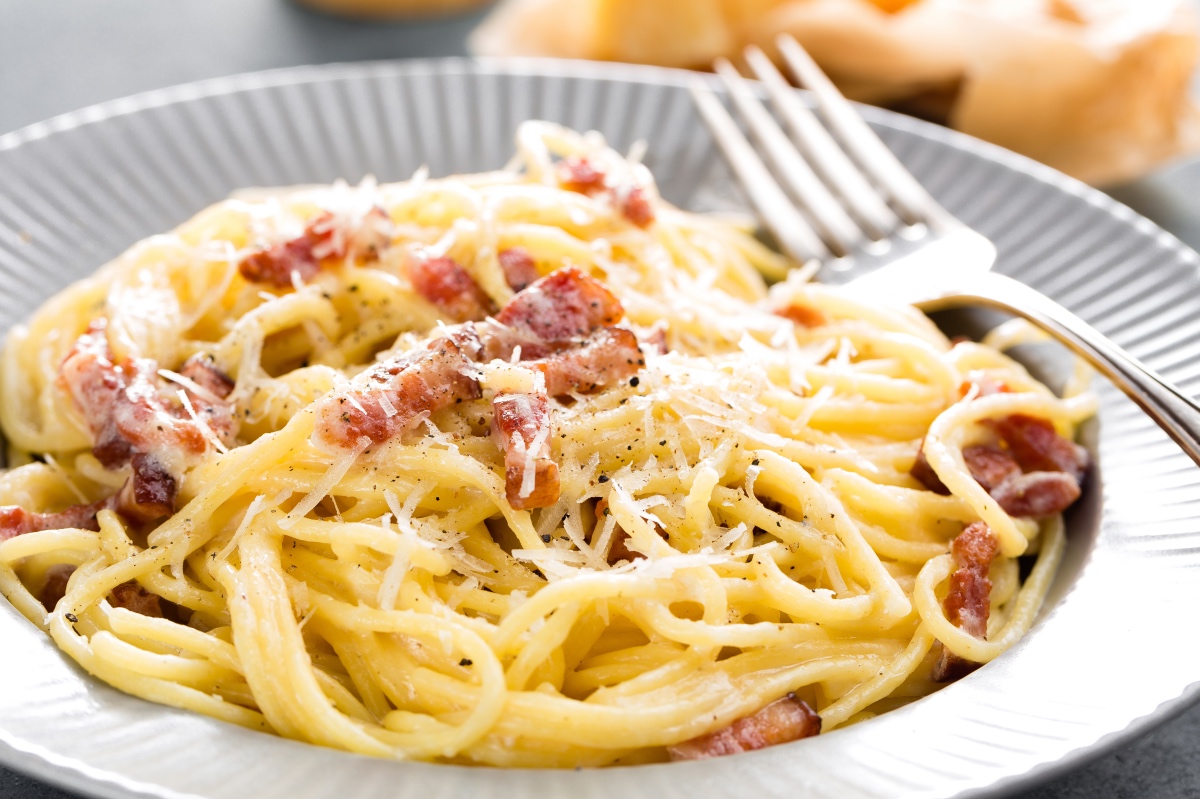Video tentang Spaghetti Carbonara: A Roman Classic, Deconstructed and Celebrated
Spaghetti Carbonara: A Roman Classic, Deconstructed and Celebrated
Spaghetti Carbonara. The name itself evokes images of creamy, rich pasta, the salty bite of guanciale, and the satisfying pepperiness that dances on the tongue. This iconic Roman dish, deceptively simple in its core ingredients, is a culinary masterpiece that has captivated palates worldwide. However, the journey from its humble origins to its globalized interpretation is a fascinating one, fraught with misconceptions and variations that often stray far from the authentic Roman experience. This article delves into the history, the proper preparation, the common pitfalls, and the enduring allure of Spaghetti Carbonara.
A History Steeped in Tradition (and a Little Mystery):
Pinpointing the exact origin of Carbonara remains a subject of debate among culinary historians. While definitive proof is elusive, several compelling theories exist. One popular narrative links its creation to the post-World War II era in Rome. American soldiers, supplying the city with rations of powdered eggs and bacon, inadvertently (or perhaps intentionally) inspired a new dish using these readily available ingredients. The theory suggests that resourceful Roman cooks adapted these unfamiliar elements into a hearty pasta dish, incorporating local staples like guanciale (cured pork jowl) and Pecorino Romano cheese.
Another theory points to a pre-war origin, suggesting that Carbonara’s roots lie in the traditional Roman culinary landscape. This perspective highlights the dish’s reliance on ingredients readily accessible to Roman families long before the arrival of American troops. Regardless of its precise genesis, what is undeniable is Carbonara’s rapid ascent to iconic status within Roman cuisine.
The Authentic Roman Recipe: A Matter of Purity:
Authentic Roman Carbonara is a testament to the power of simplicity. The core ingredients are few, but their quality is paramount:
-
Spaghetti: Use a good quality, durum wheat spaghetti. The texture and ability to hold the sauce are crucial. Avoid thinner pasta shapes, as they lack the necessary surface area.
-
Guanciale: This is the undisputed king of Carbonara. Guanciale, unlike pancetta or bacon, offers a unique, delicate fattiness and a richer, more nuanced flavour. Its rendered fat forms the base of the creamy sauce, contributing depth and umami. Attempts to substitute with pancetta or bacon fundamentally alter the dish’s character.
-
Eggs: Fresh, high-quality eggs are essential. The yolks provide the creaminess, while the whites add structure and prevent the sauce from becoming overly runny. Whole eggs are traditionally used, creating a richer, more cohesive sauce.

-
Pecorino Romano Cheese: This hard, salty sheep’s milk cheese is the cornerstone of Carbonara’s flavour profile. Its sharp, piquant taste balances the richness of the guanciale and the richness of the eggs. Parmesan, while acceptable in some variations, lacks the distinctive sharpness of Pecorino Romano.

Black Pepper: Freshly ground black pepper is generously added throughout the process, enhancing the overall flavour complexity.

The Technique: A Dance of Heat and Timing:
The preparation of Carbonara is a delicate dance of heat and timing. The key lies in the gentle cooking of the eggs and cheese, creating a creamy emulsion without scrambling the eggs. This is achieved through the residual heat of the pasta and the rendered fat from the guanciale.
The process generally unfolds as follows:
-
Cook the Guanciale: Dice the guanciale into small cubes and render it slowly over low heat until it releases its fat and becomes crispy. Remove the crispy guanciale, reserving the rendered fat in the pan.
-
Cook the Pasta: Cook the spaghetti al dente according to package directions. Reserve about ½ cup of pasta cooking water before draining.
-
Emulsify the Sauce: In a bowl, whisk together the eggs, Pecorino Romano cheese, and a generous amount of freshly ground black pepper.
-
Combine and Finish: Add the drained spaghetti to the pan with the rendered guanciale fat. Toss quickly to coat the pasta with the fat. Immediately add the egg mixture to the pasta, tossing vigorously to create a creamy emulsion. The residual heat from the pasta will cook the eggs gently. If the sauce is too thick, add a tablespoon or two of the reserved pasta water to adjust the consistency.
-
Serve Immediately: Add the crispy guanciale back to the pasta, toss gently, and serve immediately. The dish should be enjoyed while the sauce is still warm and creamy.
The Global Variations: A Divergence from Tradition:
While the authentic Roman Carbonara remains a culinary benchmark, numerous variations have emerged globally. These often include the addition of cream, which is entirely absent from the traditional recipe. The use of pancetta or bacon, while understandable given the accessibility of these ingredients, fundamentally alters the flavour profile. Similarly, the inclusion of garlic or onions is a departure from the Roman tradition, which prioritizes the pure flavours of the core ingredients.
These variations, while palatable in their own right, represent a departure from the authentic experience. They often reflect local culinary preferences and the availability of ingredients. However, it’s important to distinguish between these adaptations and the original Roman Carbonara.
The Enduring Allure: More Than Just a Dish:
Spaghetti Carbonara’s enduring appeal transcends its deliciousness. It’s a dish that embodies simplicity, tradition, and the essence of Roman culinary culture. Its relatively straightforward preparation belies the depth of flavour and the delicate balance of its ingredients. The creamy texture, the salty cheese, the rich guanciale, and the sharp pepper create a symphony of tastes that linger long after the last bite.
Beyond its culinary merits, Carbonara represents a connection to history and a celebration of regional Italian cuisine. It’s a dish that evokes a sense of place, a reminder of the rich culinary heritage of Rome. Whether enjoyed in a trattoria in the heart of Rome or recreated in a home kitchen across the globe, Spaghetti Carbonara remains a timeless classic, a testament to the enduring power of simple, well-executed cuisine. Its enduring popularity is a testament to its ability to satisfy both the palate and the soul. It’s more than just a meal; it’s an experience. So, the next time you find yourself craving a truly authentic and unforgettable pasta dish, remember the simple elegance of Spaghetti Carbonara, and strive to experience it in its purest, most traditional form.

Penutup
Therefore, we hope this article has provided valuable insights on Spaghetti Carbonara: A Roman Classic, Deconstructed and Celebrated. We thank you for the time you spent reading this article . See you in our next article!

